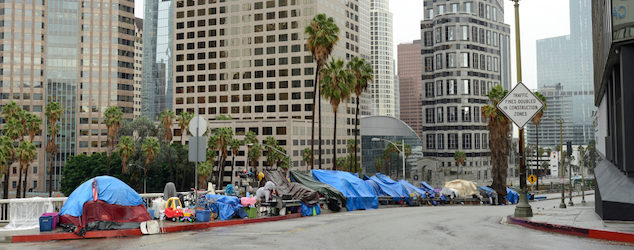Opinion
Job training and placement: Crucial to helping LA homeless
 An encampment for the homeless in Los Angeles near a freeway offramp. (Photo: image_vulture, via Shutterstock)
An encampment for the homeless in Los Angeles near a freeway offramp. (Photo: image_vulture, via Shutterstock)Data from 2020 shows more than 66,000 people are experiencing homelessness in Los Angeles County; about two-thirds of them are in the City of Los Angeles.
Unfortunately, the debate over “how to deal with homelessness” distracts from the core issues of how individuals become housing-insecure or unhoused in the first place.
In the last two years, the COVID-19 pandemic catapulted unemployment and underemployment to the top of a list of contributing factors to homelessness, as well as lack of affordable housing. The Center on Budget and Policy Priorities found the majority of jobs lost during the pandemic are in industries that pay low average wages, and that one in six American renters were behind in rent.
“Individuals who become persistently homeless use more public services and have higher public costs than their peers who do not become homeless.” — Economic Roundtable
The most tangible way to combat this financial insecurity – and thus, housing insecurity – is through good, dependable jobs. Government and corporate funders must prioritize successful workforce training and job placement programs to help individuals at high risk of homelessness gain economic stability.
First, government agencies can further invest in workforce programs tailored for the unique circumstances of people experiencing homelessness.
A 2021 report from the nonprofit Economic Roundtable notes, “The solution of employment costs less than the problem of homelessness. Individuals who become persistently homeless use more public services and have higher public costs than their peers who do not become homeless.”
The City and County of Los Angeles’ Regional Initiative for Social Enterprise (LA:RISE), for example, connects individuals who are homeless or at risk for homelessness with transitional jobs and then into jobs in the private sector, in the public sector within the City and County, or in vocational training programs. Importantly, “retention partners” act as a safety net for a year in case barriers emerge on the path to self-sufficiency.
Second, given that the private sector benefits from a healthy workforce and the community benefits from employment opportunities, the private sector has a mutually beneficial opportunity to assist the most vulnerable of job seekers.
People experiencing homelessness are often hindered by no method of identifying work opportunities, no access to email or phone for contact or follow-up, and no transportation to or appropriate clothes for job interviews. Through access centers, Los Angeles homeless services organizations are able to help individuals overcome these barriers, but depend in great part on private funding to keep these resources available.
The Google model – asking local organizations what they need to improve their communities – can be a model for other corporate organizations.
As part of its commitment to helping local communities recover from the pandemic, Google.org, Google’s philanthropic arm, recently provided grants to help People Assisting the Homeless (PATH) purchase an Americans with Disabilities Act (ADA) compliant van and tablets to help interim housing residents access job interviews, and to support Safe Place for Youth’s (SPY) access center, an entry point to resources such as no-cost connections to employment services that empower more young people to take control of their lives in a safe environment.
The Google model – asking local organizations what they need to improve their communities – can be a model for other corporate organizations looking to make an impact.
There are no quick fixes for complex challenges like homelessness, but partnership between social welfare organizations, government, and the private sector is the collaboration that provides the greatest benefit – not only for those who are housing insecure, but for everyone who lives in our community.
—
Editor’s Note: Jennifer Hark Dietz, LCSW, is the deputy chief executive officer of People Assisting the Homeless in California. Erika Hartman, LMFT, is the executive director of Safe Place for Youth in Venice.
Want to see more stories like this? Sign up for The Roundup, the free daily newsletter about California politics from the editors of Capitol Weekly. Stay up to date on the news you need to know.
Sign up below, then look for a confirmation email in your inbox.

Leave a Reply